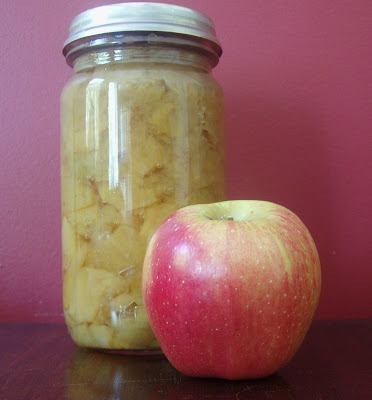
Question: What does a mother into seasonal eating do when she sees a basket of slightly wonky organic apples for $2 a kilo?
Answer: She buys 8 kilos. She spends the afternoon corralling kids to spin the apple machine – which peels, cores and slices all at once! – while she trims away a few bad bits. She then tosses the pieces into her enormous pasta pot set over low heat. When the apples are lightly stewed, she cans the lot, all the while gloating that next month's dessert is just minutes away!
In a family of five, with lots of visitors, dessert is a fairly regular event at our house. We eat apple cobbler and apple crumble; Apple Charlotte and apple dappy; apple pie and apple tart; and, on high holy days with family and friends, Amber Apple: a tart case filled with stewed apples and topped with a five-inch high cloud of meringue. Oh, it's good.
Each of these desserts starts with stewed apple – and most of these desserts takes just minutes to make if the apples are ready to go.
Whenever I stew, I use a mixture of apples. Some varieties collapse into puree; others hold their shape. By using several varieties, I end up with firm slices suspended in puree, which is, to my mind, ideal.
Sliced apples discolour quickly. However, by holding the saucepan at low heat, you can chop your apples and throw them straight into the pan over a 20 or 30 minute period. As they begin cooking straightaway, they don't discolour. Add a splash of water to the pot at the beginning, to keep everything moist, and stir regularly, lifting puree up from the bottom so that it doesn't stick and burn.
I don't sweeten the apples, as I usually find stewed apples quite sweet enough.
Incidental rhetorical question: Why do we call it 'canning' when what we are doing is putting them into glass jars?
Canned Apples This makes 4 No. 31 jars in the Fowler's system. Always follow the instructions of your preserving method; these instructions are for the Fowler's Vacola system. - 7 kg apples, in a mixture of varieties Peel, core and chop the apples, throwing the pieces as they're prepared into a large pasta pot set over low heat. Early on, add a splash of water and the juice of a lemon. Stir regularly, scraping up puree from the bottom of the pot to prevent it from sticking. When the apples are lightly stewed, take off the heat. Leave to cool. From this point, you can freeze them or can them. Since freezing requires no instructions, I'll tell you how to can them instead. The advantage of canning over freezing is that the finished product is not affected by interruptions to the power supply; it lasts for years; and you don't have to defrost before you use the contents. Thus endeth the lesson. Soak the rubber rings in warm water for 15 minutes or so. While they are soaking, wash your jars in hot soapy water. 6 to 7 kilos of stewed apples, trimmed, fills four Fowler's No. 31 jars. Slip a rubber ring over the rim of each wet jar, ensuring it is not twisted. Fill the jars with apples, leaving a ½ inch gap between the apples and the top of the jar. Put the lid on (first checking that it has no rust), then slip the clip over the lid. Place in your preserver. I have the Fowler's el cheapo but fantastic model, the Simple Natural Preserving Kit*; lucky you if you have the bigger deluxe model. My preserver fits four No. 31 jars, five if you're squishy. Cover with cold water, turn on, then turn off after an hour. If it comes to the boil during the hour, do not let it boil for longer than five minutes. Remove the jars from the preserver, using those tricky tongs, and place onto a wooden board or a pile of newspapers. Press down in the centre of each lid to ensure a good seal. Leave to stand for 12 to 18 hours, then remove the clips. Label the jars – include the date! – and put them into a low dark cupboard, preferably in a cool part of the house. (I fantasize about having a cellar, or at least a preserves cupboard.) Preserves keep for a couple of years, but they are best used within one year. After a year, the colour and texture begin to deteriorate. You can of course add spices to the jars. I don't, only because I never know until the day I use them whether I'm in the mood for cinnamon, ginger or cloves. *Actually, this smaller preserver is just the right size for us as I tend to process 'small' batches ie only 8 kg at a time. When tomato season comes around and I want to process more, I just process several nights in a row to make the year's supply of canned tomatoes and tomato sauce. Incidentally, night time is a good time to run the preserver, as the kids are in bed so there is no danger of burns. (Local: apples, lemon.) |









I'd never thought of preserving cooked fruit - this is brilliant!
ReplyDeleteI would add to the above process that it's easier to put the rubber ring on the jar before filling it with fruit. I usually remember this after about the third jar... Thanks for another great recipe.
Hi Rachel,
ReplyDeleteIn summer, I preserve lightly stewed apricots and plums. I find stewed fruit easier to pack than raw, and I like the combination of pieces and puree. Come a gloomy winter evening, when we're longing for apricots, I can whip up a crumble in minutes, pop it in the oven, and half an hour later there's summer on the table.
You're right about the rings - thanks for pointing it out.